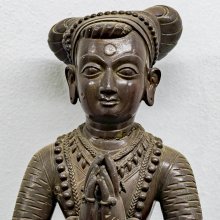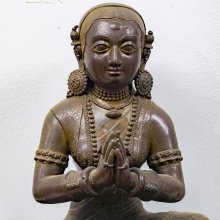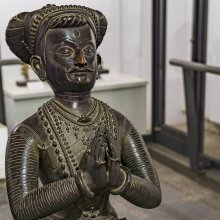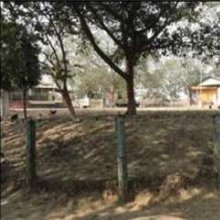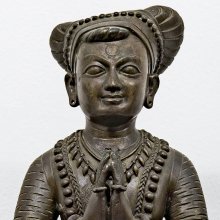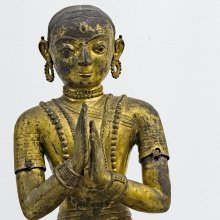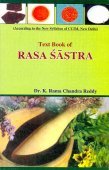Malla, Mallā, Mālla: 34 definitions
Introduction:
Malla means something in Buddhism, Pali, Hinduism, Sanskrit, Jainism, Prakrit, the history of ancient India, Marathi, Hindi, biology, Tamil. If you want to know the exact meaning, history, etymology or English translation of this term then check out the descriptions on this page. Add your comment or reference to a book if you want to contribute to this summary article.
Images (photo gallery)
(+26 more images available)
In Hinduism
Ayurveda (science of life)
Source: Wisdom Library: Āyurveda and botanyMallā (मल्ला) is another name for Mallikā (Jasminum sambac “Sambac jasmine”), from the Oleaceae family of flowering plants. The term is used throughout Ayurvedic literature such as the Carakasaṃhitā.
Source: Ancient Science of Life: Vaidyavallabha: An Authoritative Work on Ayurveda TherapeuticsMalla (मल्ल) refers to “arsenic” (whose toxic effects require treatment), and is dealt with in the 17th-century Vaidyavallabha written by Hastiruci.—The Vaidyavallabha is a work which deals with the treatment and useful for all 8 branches of Ayurveda. The text Vaidyavallabha has been designed based on the need (viz., malla) of the period of the author, availability of drugs during that time, disease manifesting in that era, socio-economical-cultural-familial-spiritual-aspects of that period Vaidyavallabha.

Āyurveda (आयुर्वेद, ayurveda) is a branch of Indian science dealing with medicine, herbalism, taxology, anatomy, surgery, alchemy and related topics. Traditional practice of Āyurveda in ancient India dates back to at least the first millenium BC. Literature is commonly written in Sanskrit using various poetic metres.
Dharmashastra (religious law)
Source: Wisdom Library: Dharma-śāstraMalla (मल्ल) refers to a “wrestler”. The word is used throughout Dharmaśāstra literature such as the Manusmṛti.

Dharmashastra (धर्मशास्त्र, dharmaśāstra) contains the instructions (shastra) regarding religious conduct of livelihood (dharma), ceremonies, jurisprudence (study of law) and more. It is categorized as smriti, an important and authoritative selection of books dealing with the Hindu lifestyle.
Purana and Itihasa (epic history)
Source: archive.org: Nilamata Purana: a cultural and literary studyMalla (मल्ल, “wrestler”) refers to one of the sub-castes that once existed in ancient Kashmir (Kaśmīra) as mentioned in the Nīlamatapurāṇa.
Source: Cologne Digital Sanskrit Dictionaries: The Purana Index1a) Malla (मल्ल).—Candraketu, a son of Lakṣmaṇa styled thus or his country?*
- * Vāyu-purāṇa 88. 188.
1b) The Lord of Rājagṛha, vanquished by Kṛṣṇa.*
- * Brahmāṇḍa-purāṇa III. 73. 100.
1c) A tribe and an eastern kingdom.*
- * Brahmāṇḍa-purāṇa II. 16. 55; Matsya-purāṇa 163. 67.
Malla (मल्ल) is a name mentioned in the Mahābhārata (cf. II.27.3, II.27.11, IV.1.9, VI.10.45) and represents one of the many proper names used for people and places. Note: The Mahābhārata (mentioning Malla) is a Sanskrit epic poem consisting of 100,000 ślokas (metrical verses) and is over 2000 years old.

The Purana (पुराण, purāṇas) refers to Sanskrit literature preserving ancient India’s vast cultural history, including historical legends, religious ceremonies, various arts and sciences. The eighteen mahapuranas total over 400,000 shlokas (metrical couplets) and date to at least several centuries BCE.
Arthashastra (politics and welfare)
Source: Shodhganga: Kakati Ganapatideva and his times (artha)Malla (मल्ल, “wrestler”) is an official title designating one of the seventy-two officers (niyoga) of the Bāhattaraniyogādhipati circle, according to the Inscriptional glossary of Andhra Pradesh (Śāsana-śabdakośāmu). The bāhattaraniyoga-adhipati is the highest executive officer of this circle (including a Malla). For example: During the reign of Gaṇapatideva, the area extending between Pānagal to Mārjavāḍi was entrusted to Gaṇḍapeṇḍāru Gangayasāhiṇi as Bāhattaraniyogādhipati. Later on, this office was entrusted to Kāyastha Jannigadeva.
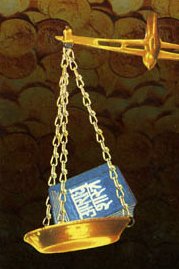
Arthashastra (अर्थशास्त्र, arthaśāstra) literature concerns itself with the teachings (shastra) of economic prosperity (artha) statecraft, politics and military tactics. The term arthashastra refers to both the name of these scientific teachings, as well as the name of a Sanskrit work included in such literature. This book was written (3rd century BCE) by by Kautilya, who flourished in the 4th century BCE.
Jyotisha (astronomy and astrology)
Source: Wisdom Library: Brihat Samhita by Varahamihira1) Malla (मल्ल) (or Mallāna) is the name of a kingdom or tribe of people, according to the Bṛhatsaṃhitā (chapter 5), an encyclopedic Sanskrit work written by Varāhamihira mainly focusing on the science of ancient Indian astronomy astronomy (Jyotiṣa).—Accordingly, “If the sun and moon should begin to be eclipsed when only half risen, deceitful men will suffer as well as sacrificial rites. [...] If they should be eclipsed when in the sign of Cancer (Karka) the Ābhīras, the Śabaras, the Pallavas, the Mallas, the Matsyas, the Kurus, the Śakas, the Pāñcālas and the Vikalās will be afflicted with miseries and food grains will be destroyed”.
2) Malla (मल्ल) refers to “wrestlers”, according to the Bṛhatsaṃhitā (chapter 15) (“On the nakṣatras—‘asterisms’”).—Accordingly, “Those who are born on the lunar day of Uttarāṣāḍha will be chief ministers or wrestlers (malla); will keep elephants and horses, will be religious; will be men of principles; soldiers; happy and of bright appearance. Those who are born on the lunar day of Śravaṇa will be cunning, of active habits, efficient workmen, bold, virtuous, god-fearing and truthful”.

Jyotisha (ज्योतिष, jyotiṣa or jyotish) refers to ‘astronomy’ or “Vedic astrology” and represents the fifth of the six Vedangas (additional sciences to be studied along with the Vedas). Jyotisha concerns itself with the study and prediction of the movements of celestial bodies, in order to calculate the auspicious time for rituals and ceremonies.
Sports, Arts and Entertainment (wordly enjoyments)
Source: archive.org: Syainika Sastra of Rudradeva with English Translation (art)Malla (मल्ल) refers to “wrestlers”, according to the Śyainika-śāstra: a Sanskrit treatise dealing with the divisions and benefits of Hunting and Hawking, written by Rājā Rudradeva (or Candradeva) in possibly the 13th century.—Accordingly, [while discussing the outlines of hawking]: “Thus in the matter of pursuing the quarry and hovering over it in a variety of ways and in inspiring confidence, the Vajas are superior to other birds. They charm the minds of connoisseurs, like wrestlers (malla) clasping and throwing, and getting up and falling down. [...]”.

This section covers the skills and profiencies of the Kalas (“performing arts”) and Shastras (“sciences”) involving ancient Indian traditions of sports, games, arts, entertainment, love-making and other means of wordly enjoyments. Traditionally these topics were dealt with in Sanskrit treatises explaing the philosophy and the justification of enjoying the pleasures of the senses.
In Buddhism
Theravada (major branch of Buddhism)
Source: Pali Kanon: Pali Proper NamesThe name of a people and their country.
The country is included in the sixteen Mahajanapadas of the Buddhas time. The kingdom, at that time, was divided into two parts, having their respective capitals in Pava and Kusinara. The Mallas of Pava were called Paveyyaka Malla, those of Kusinara, Kosinaraka. That these were separate kingdoms is shown by the fact that after the Buddhas death at Kusinara, the Mallas of Pava sent messengers to claim their share of the Buddhas relics (D.ii.165). Each had their Mote Hall.
In the Sangiti Sutta we are told that the Buddha, in the course of one of his journeys, came with five hundred followers to Pava and stayed in the Ambavana of Cunda the smith. A new Mote Hall, called Ubbhataka, had just been completed for the Mallas of Pava, and the Buddha was invited to be the first to occupy it that it might be consecrated thereby. The Buddha accepted the invitation, and preached in the Hall far into the night. It was also at Pava that the Buddha took his last meal, of Sukaramaddava, at the house of Cunda (D.ii.126f). From there he went to Kusinara, and there, as he lay dying, he sent Ananda to the Mallas of Kusinara, who were assembled in their Mote Hall to announce his approaching death. The Mallas thereupon came to the Upavattana Sala grove where the Buddha was, in order to pay him their last respects. Ananda made them stand in groups according to family, and then presented them to the Buddha, announcing the name of each family. After the Buddhas death, they met together once more in the Mote Hall, and made arrangements to pay him all the honour due to a Cakkavatti. They cremated the Buddhas body at the Makutabandhana cetiya, and then collected the relics, which they deposited in their Mote Hall, surrounding them with a lattice work of spears and a rampart of bows till they were distributed among the various claimants by Dona (D.ii.166). The Mallas, both of Pava and Kusinara, erected thupas over their respective shares of the relics and held feasts in their honour (D.ii.167).
The Malla capital of Kujsinara was, in the Buddhas day, a place of small importance. Ananda contemptuously refers to it as a little wattle and daub town in the midst of a jungle, a branch township, quite unworthy of being the scene of the Buddhas Parinibbana. But the Buddha informs Ananda that it was once Kusavati (q.v.), the mighty capital of Kusa and Mahasudassana. This shows that the Mallas had, at first, a monarchical constitution, but in the sixth century B.C. they were regarded, together with the Vajjis, as a typical example of a republic (sangha, gana) (M.i.231). The chief Mallas administered the state in turn. Those who were free from such duties engaged in trade, sometimes undertaking long caravan journeys (DA.ii.569).
-- or --
. See Tela.
Theravāda is a major branch of Buddhism having the the Pali canon (tipitaka) as their canonical literature, which includes the vinaya-pitaka (monastic rules), the sutta-pitaka (Buddhist sermons) and the abhidhamma-pitaka (philosophy and psychology).
In Jainism
General definition (in Jainism)
Source: archive.org: Een Kritische Studie Van Svayambhūdeva’s PaümacariuMalla (मल्ल) participated in the war between Rāma and Rāvaṇa, on the side of the latter, as mentioned in Svayambhūdeva’s Paumacariu (Padmacarita, Paumacariya or Rāmāyaṇapurāṇa) chapter 57ff. Svayambhū or Svayambhūdeva (8th or 9th century) was a Jain householder who probably lived in Karnataka. His work recounts the popular Rāma story as known from the older work Rāmāyaṇa (written by Vālmīki). Various chapters [mentioning Malla] are dedicated to the humongous battle whose armies (known as akṣauhiṇīs) consisted of millions of soldiers, horses and elephants, etc.
Source: archive.org: Trisastisalakapurusacaritra1) Mallā (मल्ला) is the wife of king Merumālin from Sumandira, according to chapter 5.3 [śāntinātha-caritra] of Hemacandra’s 11th century Triṣaṣṭiśalākāpuruṣacaritra: an ancient Sanskrit epic poem narrating the history and legends of sixty-three illustrious persons in Jainism.
Accordingly:—“[...] One time Sahasrāyudha’s wife, Jayanā, saw in a dream at night a golden spear with projecting rays. [...] As a result of the dream seen by Queen Jayanā the father gave the boy the name Kanakaśakti. When he had gradually passed through childhood and was in his first youth, he married properly in the city Sumandira Merumālin’s daughter, borne by Queen Mallā, endowed with beauty and grace, Kanakamālā. [...]”.
2) Malla (मल्ल) is the younger brother of Malli, according to chapter 6.6 [śrī-mallinātha-caritra].—Accordingly:—“Vaiśravaṇa’s jīva fell from Vaijayanta and became King Adīnaśatru in Hastināpura. Now Malli’s younger brother, named Malla, had a picture-gallery painted by painters out of curiosity. Among them one excellent painter had the art of painting the body as it was from the sight of one part, creating amazement by his painting. After he had seen Malli’s toe through the screen, he painted her figure just as it was with all the limbs and minor parts. [...]”.

Jainism is an Indian religion of Dharma whose doctrine revolves around harmlessness (ahimsa) towards every living being. The two major branches (Digambara and Svetambara) of Jainism stimulate self-control (or, shramana, ‘self-reliance’) and spiritual development through a path of peace for the soul to progess to the ultimate goal.
India history and geography
Source: Ancient Buddhist Texts: Geography of Early BuddhismMalla (मल्ल) refers to one of the sixteen Mahājanapadas of the Majjhimadesa (Middle Country) of ancient India, as recorded in the Pāli Buddhist texts (detailing the geography of ancient India as it was known in to Early Buddhism).—The Mallaraṭṭha or Mallārāṣṭra has been mentioned in the Aṅguttara Nikāya as one of the sixteen Mahājanapadas. The kingdom was divided into two parts which had for their capitals the cities of Kusāvati or Kusīnārā and Pāvā identical probably with Kasia (on the smaller Gondak and in the east of the Gorakhpur district) and a village named Padaraona (12 miles to the north-east of Kasia) respectively.
The Mallas had at first a monarchical constitution when their capital city had been known as Kusāvatī. But later on, in the time of the Buddha, when the monarchy came to he replaced by a republican constitution, the name of the city was changed to Kusīnārā. Besides Kusīnārā, the Mallas had other important cities namely, Bhoganagara, Anupiya and Uruvelakappa in the neighbourhood of which there existed a wide forest called Mahāvana.
Source: Cologne Digital Sanskrit Dictionaries: Indian Epigraphical GlossaryMalla.—(CII 4), a wrestler, a match. Note: malla is defined in the “Indian epigraphical glossary” as it can be found on ancient inscriptions commonly written in Sanskrit, Prakrit or Dravidian languages.

The history of India traces the identification of countries, villages, towns and other regions of India, as well as mythology, zoology, royal dynasties, rulers, tribes, local festivities and traditions and regional languages. Ancient India enjoyed religious freedom and encourages the path of Dharma, a concept common to Buddhism, Hinduism, and Jainism.
Biology (plants and animals)
Source: Google Books: CRC World Dictionary (Regional names)1) Malla in India is the name of a plant defined with Jasminum sambac in various botanical sources. This page contains potential references in Ayurveda, modern medicine, and other folk traditions or local practices It has the synonym Nyctanthes undulata L. (among others).
2) Malla is also identified with Ziziphus nummularia It has the synonym Ziziphus nummularia Aubrév. (etc.).
3) Malla in Sierra Leone is also identified with Oryza sativa It has the synonym Oryza elongata (Desv.) Steud. (etc.).
Example references for further research on medicinal uses or toxicity (see latin names for full list):
· Flora Cochinchinensis (1790)
· Bulletin de la Société d’Histoire Naturelle d’Autun (1893)
· Dictionary of the economic products of India (1891)
· Botany and History of Hortus Malabaricus (1980)
· Flora of the British India (1882)
· Journal of Wuhan Botanical Research (1985)
If you are looking for specific details regarding Malla, for example side effects, health benefits, chemical composition, diet and recipes, extract dosage, pregnancy safety, have a look at these references.

This sections includes definitions from the five kingdoms of living things: Animals, Plants, Fungi, Protists and Monera. It will include both the official binomial nomenclature (scientific names usually in Latin) as well as regional spellings and variants.
Languages of India and abroad
Pali-English dictionary
Source: BuddhaSasana: Concise Pali-English Dictionarymalla : (m.) a wrestler; a man of the Malla clan.
Source: Sutta: The Pali Text Society's Pali-English DictionaryMalla, (cp. Sk. malla, perhaps a local term, cp. Cānura) a wrestler Vin. II, 105 (°muṭṭhika) J. IV, 81 (two, named Cānura and Muṭṭhika “fister”); Vism. 31 (muṭṭhika+, i.e. boxing & wrestling as amusements: see mada 1). Perhaps as “porter” Bdhgh on CV V, 29. 5 (see Vin. II, 319). At Miln. 191 the mallā are mentioned as a group or company; their designation might here refer to the Mallas, a tribe, as other tribes are given at the same passage (e.g. Atoṇā, Pisācā). Cp. Bhallaka.

Pali is the language of the Tipiṭaka, which is the sacred canon of Theravāda Buddhism and contains much of the Buddha’s speech. Closeley related to Sanskrit, both languages are used interchangeably between religions.
Marathi-English dictionary
Source: DDSA: The Molesworth Marathi and English Dictionarymalla (मल्ल).—m (S) An athlete or wrestler; also a pugilist or boxer, esp. as professional. 2 fig. An athletic person.
Source: DDSA: The Aryabhusan school dictionary, Marathi-Englishmalla (मल्ल).—m A wrestler. Fig. An athletic person.
Marathi is an Indo-European language having over 70 million native speakers people in (predominantly) Maharashtra India. Marathi, like many other Indo-Aryan languages, evolved from early forms of Prakrit, which itself is a subset of Sanskrit, one of the most ancient languages of the world.
Sanskrit dictionary
Source: DDSA: The practical Sanskrit-English dictionaryMalla (मल्ल).—a. [mall-ac]
1) Strong, athletic, robust; Ki. 18.8.
2) Good, excellent.
-llaḥ 1 A strong man.
2) An athlete, a boxer, wrestler; प्रभुर्मल्लो मल्लाय (prabhurmallo mallāya) Mahābhārata
3) A drinking-vessel, cup.
4) The remnants of an oblation.
5) The cheek and temple.
6) Name of a mixed tribe (wrestlers) born of an outcast Kṣatriya by a Kṣatriya woman; झल्लो मल्लश्च राजन्याद् व्रात्यान्निच्छिविरेव च (jhallo mallaśca rājanyād vrātyānnicchivireva ca) Ms. 1.22;12.45.
7) Name of a country.
-mallā 1 A woman.
2) The Arabian jasmine.
3) Ornamenting the person with cosmetics or coloured unguents.
--- OR ---
Mālla (माल्ल).—Name of a particular mixed tribe.
Derivable forms: māllaḥ (माल्लः).
See also (synonyms): mālu.
Source: Cologne Digital Sanskrit Dictionaries: Edgerton Buddhist Hybrid Sanskrit DictionaryMalla (मल्ल).—(m. ? = Sanskrit Lex. and [Jaina Māhārāṣṭrī] id.; also = next, q.v.; compare koṭṭa-, kroḍa-malla), pot, bowl, vessel: only in [bahuvrīhi] [compound] (riktahastā) rikta-mallāś ca Divyāvadāna 171.27.
Source: Cologne Digital Sanskrit Dictionaries: Shabda-Sagara Sanskrit-English DictionaryMalla (मल्ल).—mfn.
(-llaḥ-llā-llaṃ) 1. Strong, stout, athletic, robust. 2. Best, excellent m.
(-llaḥ) 1. A wrestler, a boxer, by birth; the offspring of an outcaste Kshetriya by a Kshetriya female. 2. A cup or vessel. 3. The cheek and temples, the hemicranium. 4. A kind of fish. 5. The residue of an oblation. f.
(-llā) 1. A woman. 2. Arabian jasmine. 3. Ornamenting the person with coloured unguents. E. mall to hold, aff. ac .
--- OR ---
Mālla (माल्ल).—m.
(-llaḥ) Name of a mixed tribe.
Source: Cologne Digital Sanskrit Dictionaries: Benfey Sanskrit-English DictionaryMalla (मल्ल).—I. adj. 1. Strong. 2. Excellent. Ii. m. 1. A wrestler; the son of an outcaste Kṣatriya, [Mānavadharmaśāstra] 10, 22; 12, 45. 2. A cup. 3. The hemicranium. 4. The residue of an oblation. Iii. f. lā. 1. A woman. 2. Arabian jasmine.
Source: Cologne Digital Sanskrit Dictionaries: Cappeller Sanskrit-English DictionaryMalla (मल्ल).—[masculine] wrestler by profession, athlete; [plural] [Name] of a caste & a people.
Source: Cologne Digital Sanskrit Dictionaries: Aufrecht Catalogus CatalogorumMalla (मल्ल) as mentioned in Aufrecht’s Catalogus Catalogorum:—of the Puṣkara family, son of Śuka, grandson of Jayarāma: Kirātārjunīyaṭīkā.
Source: Cologne Digital Sanskrit Dictionaries: Monier-Williams Sanskrit-English Dictionary1) Malla (मल्ल):—m. a wrestler or boxer by profession (the offspring of an out-caste Kṣatriya by a Kṣ° female who was previously the wife of another out-caste, [Manu-smṛti x, 22; xii, 45]), an athlete, a very strong man, [Mahābhārata; Harivaṃśa; Varāha-mihira] etc.
2) Name of a king called Nārāyaṇa, [Catalogue(s)]
3) of the 21st Arhat of the future Utsarpiṇī, [cf. Lexicographers, esp. such as amarasiṃha, halāyudha, hemacandra, etc.]
4) of an Asura (See mallāsura)
5) of various men, [Rājataraṅgiṇī]
6) a vessel, boiler, [Divyāvadāna] (also f(ī). , [cf. Lexicographers, esp. such as amarasiṃha, halāyudha, hemacandra, etc.])
7) the remnant of an oblation, [cf. Lexicographers, esp. such as amarasiṃha, halāyudha, hemacandra, etc.]
8) a kind of fish (= kapālin), [cf. Lexicographers, esp. such as amarasiṃha, halāyudha, hemacandra, etc.]
9) the cheek and temples, [cf. Lexicographers, esp. such as amarasiṃha, halāyudha, hemacandra, etc.]
10) [plural] Name of a people, [Mahābhārata; Harivaṃśa] etc.
11) Mallā (मल्ला):—[from malla] f. a woman, [cf. Lexicographers, esp. such as amarasiṃha, halāyudha, hemacandra, etc.]
12) [v.s. ...] Name of two women, [Rājataraṅgiṇī]
13) [v.s. ...] ornamenting the person with coloured unguents (= pattra-vallī), [cf. Lexicographers, esp. such as amarasiṃha, halāyudha, hemacandra, etc.]
14) [v.s. ...] Arabian jasmine (cf. mallikā), [cf. Lexicographers, esp. such as amarasiṃha, halāyudha, hemacandra, etc.]
15) Malla (मल्ल):—mfn. strong, robust, [cf. Lexicographers, esp. such as amarasiṃha, halāyudha, hemacandra, etc.]
16) good, excellent, [cf. Lexicographers, esp. such as amarasiṃha, halāyudha, hemacandra, etc.]
17) Mālla (माल्ल):—m. ([from] malla [gana] sāṃkalādi) Name of a [particular] mixed caste (cf. mālu).
Source: Cologne Digital Sanskrit Dictionaries: Yates Sanskrit-English DictionaryMalla (मल्ल):—(llaḥ) 1. m. A wrestler; the check; a cup; kind of fish; offals of a sacrifice. f. A woman; Arabian jasmin; perfuming. a. Stout; best.
Source: DDSA: Paia-sadda-mahannavo; a comprehensive Prakrit Hindi dictionary (S)Malla (मल्ल) in the Sanskrit language is related to the Prakrit word: Malla.
[Sanskrit to German]
Sanskrit, also spelled संस्कृतम् (saṃskṛtam), is an ancient language of India commonly seen as the grandmother of the Indo-European language family (even English!). Closely allied with Prakrit and Pali, Sanskrit is more exhaustive in both grammar and terms and has the most extensive collection of literature in the world, greatly surpassing its sister-languages Greek and Latin.
Hindi dictionary
Source: DDSA: A practical Hindi-English dictionaryMalla (मल्ल) [Also spelled mall]:—(nm) a wrestler; ~[krīḍā] wrestling, wrestling sport; -[bhūmi/śālā]the arena; —[yuddha] wrestling, hand to hand fight; —[vidyā] the art of wrestling.
...
Prakrit-English dictionary
Source: DDSA: Paia-sadda-mahannavo; a comprehensive Prakrit Hindi dictionary1) Malla (मल्ल) in the Prakrit language is related to the Sanskrit word: Malla.
2) Malla (मल्ल) also relates to the Sanskrit word: Malla.
3) Malla (मल्ल) also relates to the Sanskrit word: Mālya.
Prakrit is an ancient language closely associated with both Pali and Sanskrit. Jain literature is often composed in this language or sub-dialects, such as the Agamas and their commentaries which are written in Ardhamagadhi and Maharashtri Prakrit. The earliest extant texts can be dated to as early as the 4th century BCE although core portions might be older.
Kannada-English dictionary
Source: Alar: Kannada-English corpusMalla (ಮಲ್ಲ):—[adjective] having necessary power, skill; able; efficient.
--- OR ---
Malla (ಮಲ್ಲ):—
1) [noun] a man who wrestles; a wrestler.
2) [noun] a physically strong man.
3) [noun] an able, efficient man.
--- OR ---
Maḷḷa (ಮಳ್ಳ):—[adjective] lacking good sense; lacking normal intelligence; foolish; stupid.
--- OR ---
Maḷḷa (ಮಳ್ಳ):—
1) [noun] a hallucinated man.
2) [noun] a mad fellow.
3) [noun] a foolish, stupid fellow.
4) [noun] a man who is under a spell.
5) [noun] a man who is fascinated or is charmed.
Kannada is a Dravidian language (as opposed to the Indo-European language family) mainly spoken in the southwestern region of India.
See also (Relevant definitions)
Starts with (+165): Malla nim, Malla-adambu-ballu, Malla-kara, Malla-mada, Malla-maderi-ballu, Malla-nandi-mada, Malla-yuttakai, Mallaali, Mallabandhantara, Mallabhatiturya, Mallabhatta, Mallabhavana, Mallabhu, Mallabhumi, Mallacetti, Malladala, Malladarsha, Malladeva, Malladi, Malladvadashi.
Ends with (+81): Adakamalla, Adhamalla, Ahavamalla, Akshotamalla, Alamalla, Ammalla, Anihatamalla, Anumalla, Apratimalla, Aradakvamalla, Arighatemalla, Ashokamalla, Bharatamalla, Bhattamalla, Canuramalla, Caupatamalla, Cauvatamalla, Cavupatamalla, Chanuramalla, Cherimalla.
Full-text (+345): Mallayuddha, Mallabhu, Nagamalla, Mallari, Malu, Mallayatra, Mallam-tsjulli, Kusinara, Mallavastava, Mallapuramahatmya, Mallasomayajin, Mallapura, Makutabandhana, Mallaja, Papa, Hastimalla, Kushigramaka, Mallavi, Mallavidya, Pava.
Relevant text
Search found 85 books and stories containing Malla, Mallā, Mālla, Maḷḷa; (plurals include: Mallas, Mallās, Māllas, Maḷḷas). You can also click to the full overview containing English textual excerpts. Below are direct links for the most relevant articles:
Garga Samhita (English) (by Danavir Goswami)
Verses 5.7.36-37 < [Chapter 7 - The Killing of Kuvalayāpīḍa]
Verse 1.6.17 < [Chapter 6 - Description of Kaṃsa’s Strength]
Verses 5.8.8-9 < [Chapter 8 - The Killing of Kaṃsa]
Dhammapada (Illustrated) (by Ven. Weagoda Sarada Maha Thero)
Verse 206-208 - The Story of Sakka < [Chapter 15 - Sukha Vagga (Happiness)]
Verse 254-255 - The Story of Subhadda the Wandering Ascetic < [Chapter 18 - Mala Vagga (Impurities)]
Verse 396 - What is a Brāhman? < [Chapter 26 - Brāhmaṇa Vagga (The Brāhmaṇa)]
Sahitya-kaumudi by Baladeva Vidyabhushana (by Gaurapada Dāsa)
Text 7.134 < [Chapter 7 - Literary Faults]
The Great Chronicle of Buddhas (by Ven. Mingun Sayadaw)
Part 45 - The Malla Princes pay their Last Respects to the Buddha < [Chapter 40 - The Buddha Declared the Seven Factors of Non-Decline for Rulers]
Part 33 - The Story of Pukkusa, the Malla Prince < [Chapter 40 - The Buddha Declared the Seven Factors of Non-Decline for Rulers]
Part 44 - The Buddha discoursed on the Mahāsudassana Sutta < [Chapter 40 - The Buddha Declared the Seven Factors of Non-Decline for Rulers]
Manusmriti with the Commentary of Medhatithi (by Ganganatha Jha)
Verse 12.45 < [Section VIII - States of Existence due to the Three Qualities]
Verse 10.22-23 < [Section II - Mixed Castes]
Vinaya Pitaka (3): Khandhaka (by I. B. Horner)
The story Roja the Malla < [6. Medicine (Bhesajja)]
Allowance for Kaṭhina < [7. Kaṭhina]
The five boons for Mahākaccana < [5. Leather (Camma)]
Related products
